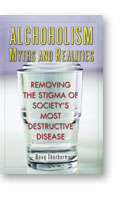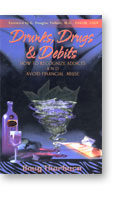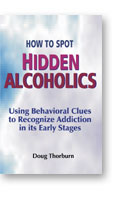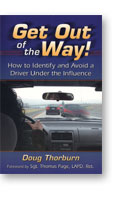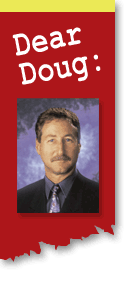|

DUIs as a clue to danger lurking elsewhere: celebrity plastic surgeon Jan Adams
Something I've said before bears repeating: I have long bemoaned the fact that the press discloses the drinking and using foibles of celebrities and sports figures while generally failing to report any evidence of use in law enforcers, politicians, CEOs, attorneys and doctors. In my files of likely and confirmed alcoholics, for every celebrity suspected strictly on behavioral clues, four or five are confirmed addicts; out of every four or five law enforcers suspected, there is only one in whom I can prove alcoholism. Yet, the behaviors are similar in all those under suspicion, celebrities and non-celebrities alike. Therefore, hidden alcoholism is likely epidemic in the non-celebrities who qualify for these pages, who are usually relegated to the "Under Watch" section only because we lack confirmation of addictive use of alcohol or other drugs. Illinois state police sergeant Drew Peterson and Former New York City police commissioner Bernard Kerik, discussed in the "Under Watch" section of this issue, are cases in point. However, every once in a while, alcohol or other-drug addiction is obvious in the public record among non-celebrity non-law enforcers, because they don't have as many friends in high places willing to cover it up. It helps, however, if they have celebrity status, even if we ordinarily wouldn't think of them as such.
Plastic surgeon Jan Adams, 53, manifested long-standing alcoholism in several public incidents before performing surgery on rapper Kanye West's mother Donda West, who died shortly after the procedure at age 58. He allegedly lost control of his vehicle and struck a parked car in September 2002. While he wasn't tested, subsequent events, including a plea of no contest to a charge of DUI in January 2003, suggests he was likely under the influence. Three years later Adams was found guilty of driving with a BAL over .08 per cent, for which he was sentenced to 96 hours in jail and given five years probation. Two arrests for DUI or its equivalent are an indication of alcoholism with almost no false readings, especially in someone long past his fraternity years.
In addition, unconfirmed private reports also indicate alcoholism. Ex-girlfriend Deborah Pratt, in papers seeking a restraining order filed in L.A. Superior Court, stated that alcohol brings out Adams' "Jekyll and Hyde personality" and that the defendant "has an unfortunate drinking problem." She also alleged he had been abusive when intoxicated in the presence of her children. Such behaviors simply do not occur in the absence of alcoholism and the "Jekyll and Hyde" description increases the confidence level of a correct diagnosis to nearly 100%.
But why should we care? For one thing, half of all road carnage is committed by the 10% of the population consisting of addicts. This 10% is probably driving while under the influence on average roughly 20% of the time. From this we can conclude that (20% of 10% =) 2% of road miles are driven by alcoholics while under the influence, which are responsible for half of all road fatalities. In the absence of road hazards such as inclement weather, DUIs might be responsible for 80% of highway deaths.
I use this estimate, along with other evidence, to make the case in Drunks, Drugs & Debits that 80% of society's ills, woes and dysfunctions can be attributed to alcohol and other-drug addiction. In one study 70% of snowmobile accidents were caused by operators under the influence; another one shows that 90% of household fires can be traced to errors in judgment or malicious intent by alcoholics. An estimate that alcoholism might be responsible for 80% of fatal and not-quite-fatal errors made by doctors and surgeons is consistent with the evidence.
Many alcoholics are highly functional and competent through much of their drinking careers. There is no proof that Dr. Adams, who was a celebrity plastic surgeon with his own show on Discovery Health and a number of guest expert interviews to his credit on "Oprah," "The Other Half," "Entertainment Tonight" and "Extra," is responsible for the death of Donda West. However, another surgeon, Dr. Andre Aboolian, reportedly told Ms. West he needed medical clearance for a pre-existing condition that could cause a heart attack during surgery before he would operate. It doesn't appear that she obtained such clearance. The difference is that a sober doctor would have been less likely to perform the procedure than a practicing alcoholic. The non-alcoholic is far less likely to take unnecessary risks. Even the Medical Board of California seems to acknowledge there is a difference between doctors with and without DUIs, since as a result of the public incidents--oh, and perhaps several settled lawsuits over alleged malpractice--it is considering revoking or suspending his license to practice.
Alcoholics experience a sense they can do no wrong. This feeling tends to permeate their thinking and actions, which translate to unnecessarily risky behaviors. Quite simply, they are in the aggregate far bigger risk-takers than non-addicts. While this can work to their and, perversely, even society's benefit, sometimes the risks don't pan out. This may have been one of those cases.
Runners-up for top story of the month:
Rodney King, who was filmed in 1991 being beaten by four Los Angeles police officers after speeding and evading arrest while on parole for a robbery conviction (the police acquittals for which touched off the 1992 L.A. riots), was recently riding his bicycle after 11 p.m. Most grown-ups wouldn't be riding a bicycle and, if they were, wouldn’t be doing so at 11 p.m., but King is, well, no ordinary guy. He claims he was confronted by a man and a woman demanding his bike. Most grown-ups, who wouldn't find themselves in such a situation at 11 p.m. in the first place, would likely just hand over the bike. But, King, again, is no ordinary guy. He refused and, as he rode off, was sprayed with shotgun pellets. He pedaled a mile to his home, where he called 911. Police, who responded before the medics, said King and "others at the home" were so intoxicated and uncooperative they found it difficult to decipher what happened. They were still puzzled by the incident days later. But King is no ordinary guy--he's a full-blown alcohol and other-drug addict, so rather than being puzzled they should simply be happy they didn't have to analyze blood samples for a homicide investigation.
King's case is a classic in the annals of unchecked alcoholism and the affect it has on the lives of others. In 1991 he was arrested on suspicion of trying to run over a vice officer who allegedly found him with a transvestite prostitute. In 1993 he crashed his car into a block wall with a blood alcohol level of over .16 per cent. In 1995 he was convicted of hit-and-run after hitting his wife with his car. (She lived.) In 1999 he spent 90 days in the slammer and was required to attend a batterer's treatment program after a domestic dispute. (Once again, the law treated symptoms rather than cause, allowing the disease to progress.) In 2001 he was ordered into a year long drug treatment program after an arrest for indecent exposure while under the influence of PCP. (I once viewed an arrest of someone on PCP. It took five cops over ten minutes to get him in handcuffs.) In early 2003 he crashed through a fence and into a house after weaving through traffic in his Ford Expedition at over 100 mph. In late 2003 he was arrested on suspicion of punching his girlfriend in the stomach. In 2005 he was arrested on suspicion of threatening to kill one of his daughters and her mother. In 2007 police have been to his home "numerous times." Even though police overreacted (which a non-professional like me might do if involved in a high-speed pursuit of a convicted felon running several red lights and stop signs, who continued to resist arrest after finally stopping despite being tasered, tackled and struck with batons, strongly supporting the officers' belief he was high on PCP), King's behaviors led indirectly to nearly $1 billion in property damage, 55 deaths and almost 2,400 injuries. While it is unlikely that King will ever be directly responsible for even a fraction of such destruction, unless his long-time addiction is quashed he will continue to pose a danger to others and drain public resources.
Psychiatrist Jaroslav Skala, who established the first Czech center for the treatment of alcoholism in 1948, dead at 91. Skala, who got sober in 1951--interestingly, three years after founding the center he headed until retiring in 1982, conducted over 100 studies on addiction.
Under watch:
Richard Roberts, son of school founder and televangelist Oral Roberts, who resigned from his position as president of Oral Roberts University. In a lawsuit filed by three dismissed university professors Roberts was accused of misspending university funds to support a lavish lifestyle, including allegations of a $39,000 shopping spree for Roberts' wife, Lindsay Roberts, a $29,000 trip on the university jet to the Bahamas for one of their daughters, and the purchase of a stable of horses for their children. The resignation came on the heels of an amended lawsuit, which included an internal ministry report titled "Scandal Vulnerability Assessment," documenting allegations of misconduct by the Roberts family. Among other indications that alcoholism is heavily involved somewhere, the detailed account alleges that Lindsay spent the night in the Oral Roberts University guesthouse with an underage male "on nine separate occasions." The internal report, prepared by Richard Roberts' sister-in-law, Stephanie Cantees, was found by an Oral Roberts University student while he was repairing Cantees' laptop computer. The student provided a copy of the report to the professors. If there's an addict in here somewhere, it wouldn't be the first in the family: Roberts' eldest son, Ronald Roberts, committed suicide in June 1982 at the age of 37 after a court order required him to get counseling at a drug treatment center.
Anthony Marshall, 83, son of the late philanthropist and Manhattan socialite Brooke Astor, charged with falsifying records, grand larceny and scheming to defraud his mother's estate out of millions of dollars. The indictment alleges that Marshall and his former attorney, Francis X. Morrissey Jr., cooperated in forging Astor's signature in a codicil to her will in which she left most of her $198 million fortune to Marshall rather than to step-children of subsequent marriages and his own son, Philip Marshall, 54. The point of interest to the addictionologist is Astor's first husband and father of Marshall, New Jersey Republican councilman, assemblyman and state senator John Dryden Kuser, with whom her marriage was highlighted by Kuser’s "physical abuse, alcoholism and adultery." She got lucky--he asked her to leave him, which she did in 1931 after dutifully waiting for the successful culmination of his New Jersey senatorial campaign, thereby enabling him to yet higher office. Soon after, she married Charles H. Marshall and, when he died in 1952, she married Vincent Astor of the famous Astor family. Marshall, who adopted his mother's second husband's surname at age 18, is accused by his son, Philip, of mistreating her, including an allegation of denying medical care and letting her sleep in her dilapidated Park Avenue residence on a couch reeking of urine, which triggered a criminal investigation leading to the indictments. The elder Marshall could easily spend the rest of his life behind bars--which, if convicted, would likely be due either to misbehaviors stemming from his own alcoholism or going through life as an untreated codependent to his long-dead father, from whom he may have learned awful lessons.
Trial lawyer Richard F. Scruggs, one of the richest men in Mississippi, accused of attempting to bribe a state judge presiding over a lawsuit involving millions in legal fees. Scruggs, who is related through marriage to Majority Leader of the U.S. Senate Trent Lott, was indicted with four others, including his lawyer son David Z. Scruggs. The five-some allegedly offered Mississippi Third Circuit Court Judge Henry L. Lackey (who cooperated with the federal government in the investigation) $50,000 for a favorable ruling over fees relating to the Scruggs Katrina Group Litigation Team, which has fought the insurance industry's alleged failure to adequately reimburse homeowners for losses due to Hurricane Katrina. Scruggs' fellow attorneys wonder why a man of his wealth and fame (he is known as one of the prime movers in class action lawsuits against the asbestos industry and for his role--dramatized in the 1999 film "The Insider"--in the government's case in the 1990s against the tobacco industry, which settled for $248 billion) would allegedly risk so much over a few million dollars in legal fees. "It just boggles the mind," said fellow trial attorney Jack Denton. "Here is a man who has had an enormous amount of success, who reached a level very few attorneys, if any, have reached. Why would he risk everything over a legal dispute over attorneys' fees?" Only those few of us who grasp the most common root cause of egomania manifesting itself as overachievement, a need to win regardless of cost and (allegedly) felonious behaviors can answer this otherwise befuddling question. In the meantime, a fundraiser to be held at Scruggs' home for Senator Hillary Clinton, in which former President Clinton was scheduled to appear, has been cancelled.
Lawyer Stephen G. Yagman, who made a career of suing law enforcement agencies, sentenced to three years in prison for tax evasion, money laundering and bankruptcy fraud. He made the "Under Watch" section of the August 2007 Report, where you can read about his antics in a legal system that frequently pits addicts against addicts. The judge in the case, Stephen V. Wilson, concluded that Yagman had not only committed the crimes but also lied to cover his tracks. "Frankly, I was shocked by his testimony," Wilson said, calling it "transparently untrue in so many areas." The addiction aware would ask only how many of his cases were fought with similar fabrications. U.S. attorney Thomas P. O'Brien commented, "Mr. Yagman, who as an attorney had a special obligation to follow the rules, chose not to do so." One mark of an alcoholic is acting like "The rules don't apply to me," clue # 7 in the chapter, "A Supreme Being Complex," in How to Spot Hidden Alcoholics. As usual, we'll give Mr. Yagman the benefit of the doubt and assume that alcoholism explains--but does not excuse his behaviors.
Former New York City police commissioner Bernard Kerik, who was once nominated to head the federal Department of Homeland Security, indicted on 16 counts of conspiracy, tax fraud and making false statements to federal agents. Kerik could be a classic in the chronicles of hidden alcoholism. If it were only the fact that he withdrew his name from nomination because he didn't pay the nanny tax, Kerik wouldn't be "under watch." However, prior to this he abandoned an illegitimate Korean daughter, accepted undisclosed gifts from firms doing business with New York City, had at least two mistresses, declared bankruptcy, was expelled from Saudi Arabia after a physical confrontation with a local police official, and ignored an arrest warrant for failure to pay his debts. He is accused of:
1. hiding hundreds of thousands of dollars received while heading up New York's Department of Corrections, as police commissioner and later as one of presidential candidate Rudy Guliani's business partners,
2. accepting a $255,000 apartment renovation, including Jacuzzi and marble rotunda, in exchange for working to get city contracts for a Mafia-connected company,
3. concealing this income, rent payments a New York real estate developer made for him on an Upper East Side apartment and more than $75,000 from a book contract, and
4. lying to three different White House officials about his tax and financial histories when applying for his positions as Homeland Security chief and senior policy adviser to the Coalition Provisional Authority, which governed Iraq after the 2003 invasion, where he led and failed in the effort to establish and properly train the Iraqi police force.
As a former Parks Commissioner wrote, while many officials have gotten into trouble for one of the many indiscretions of which Kerik has been accused, "it is rare for anyone to be under fire" for all of these issues. According to the indictment, he complained that his civil servant salary was inadequate and he "felt like he was on welfare." In what may be a grand example of the paradox of addiction--the highly functional alcoholic who achieves extraordinary success ("sometimes it takes an addict") while abusing others and living by a "rules don't apply to me" attitude--he is credited with cutting NYC shootings by 74% and overall crime by 60% while police commissioner. The unusual variety of behaviors could stem from having had an alcoholic mother, who was murdered by her pimp when Kerik was a child. However, a rare sign of alcoholic egomania is to have busts made of oneself--think Josef Stalin, Kim Jong Il and the late former dictator of Turkmenistan, Saparmurat Niyazov--all confirmed alcoholics. Kerik once used city funds to commission 30 plaster busts of himself to be distributed as gifts to friends and dignitaries.
Illinois state police sergeant Drew Peterson, whose fourth wife, Stacy Ann, mysteriously disappeared in late October. Days later, investigators re-opened the case of his third wife, Kathleen Savio, who died in 2004 by what was then determined to be accidental drowning. Such coincidences--along with four marriages (as mentioned in Drunks, Drugs & Debits, 85% odds of alcoholism), the last two to women far younger--in themselves suggest a high likelihood of foul play rooted in alcoholism.
Further evidence includes a temporary order of protection against Peterson in 2002 after Savio alleged he physically abused her. In a letter to the state's attorney’s office, she wrote that he had been having an affair with a minor and feared her husband might try to kill her. The family members, who had repeatedly been told she feared her husband, refused to believe an inquest's finding that her drowning had been an accident. After a review of crime scene and autopsy photographs, it was found that a one-inch gash to her head had not rendered her unconscious, which would have been necessary for her to accidentally drown. A judge, with the support of Savio's family granted a petition to exhume Savio's body.
Linda Marie Bollea, aka Linda Hogan, 47, whose 23-year marriage to Terry Bollea, aka Hulk Hogan, 54, was reportedly marked by multi-thousand dollar shopping sprees for items she'd use or wear only once and a party-hearty lifestyle, filing divorce papers. Hulk, who consulted with divorce attorneys months earlier, is said to prefer a low-key lifestyle, while Linda loved being the center of attention late-night on the town. In the meantime, their son Nick Bollea, 17, was arrested on charges of felony reckless driving involving serious bodily injury for an incident in August in which he was reportedly street racing, struck a curb, spun across two lanes of traffic and slammed rear-end first into a tree. While Nick was wearing a seat belt, his passenger, John Graziano, 22, who has been comatose since the incident, was not. Since Hulk owned the car, he could be on the hook for a multi-million dollar settlement.
Enabler of the Month:
UCLA professor Frances Ohlsen, who asked civil-rights attorney Stephen Yagman to teach an undergraduate course on law, morality and social justice. Yagman, 63, was convicted of evading more than $100,000 in federal income taxes while living a reportedly lavish lifestyle, including Aspen vacations and wearing high-end suits from London. He was also convicted of bankruptcy fraud after filing for bankruptcy in 1999, even though living in a 2,800 square foot home in the Los Angeles area beach town of Venice. I'd love to hear him discuss morality.
Disenablers of the Month:
Spain's King Juan Carlos who told Venezuelan dictator Hugo Chavez to "shut up" at a Latin American-Spanish-Portuguese summit. Chavez repeatedly referred to former Spanish Prime Minister Jose Maria Aznar as a "fascist," adding in his typical hyperbolic fashion that "fascists are not human" and "a snake is more human." Spain’s current prime minister, Jose Luis Rodriguez Zapatero, elicited applause from the gathering when responding, "Former President Aznar was a...legitimate [democratically elected] representative of the Spanish people." Although Chavez' microphone was shut off, he repeatedly tried to interrupt and talk over the Spanish head of state. Hearing enough, Juan Carlos angrily leaned forward, looked directly at Chavez and said, "Why don't you shut up?"
Sabina Morgan who, while telling her husband "30 Rock" star Tracy Morgan he's a good father to their teenage sons, kicked him out of the house, allowing him to return only on the condition that he stay sober. He'd worked the program well enough, so she took him back after he'd been out for several weeks. We'll see if it takes, but Sabina's got the right idea.
Bill Nye the Science Guy, who sought a permanent restraining order against his ex-fiancee Blair Tindall, 47, because she poured weed killer on his vegetable garden. According to The Smoking Gun, Tindall describes the assault as a '''foolish, sophomoric act of poor judgment' that came in the midst of her having a series of personal and family problems." In her memoir, Mozart in the Jungle, Blair described how she bedded and drugged her way up the classical career ladder in New York City in her teens, 20s and 30s.
Sometimes, it takes an addict:
Two-time Pulitzer Prize-winning author Norman Mailer, dead of renal failure at 84. Mailer transformed American journalism by introducing to nonfiction some of the techniques of the novelist and by placing himself, a brilliant, flawed and larger-than-life character, at the center of his reporting. Mailer was drunk or stoned during most of the 1950s, tried to feed vodka to a horse, which bit him in return, and stabbed and seriously wounded his second of six wives in 1960. Among other controversies, he ran for mayor of New York City in 1969, campaigning to secede from New York and make the City the 51st state. He entered into a long feud with feminists after debating Germaine Greer in 1971 and declared himself an "enemy of birth control." After helping Jack Henry Abbott, a Utah prison inmate, publish a series of letters in an acclaimed volume, In the Belly of the Beast, Mailer lobbied to have him paroled. A few weeks after his release in 1981, Abbott killed a man in New York and Mailer's champion turned to national outrage. In 1980, he wed and divorced his fifth wife within a few days to grant legitimacy to their daughter and later that year married his final wife, to whom he apparently remained happily married until his death. At this point, Mailer became, shall we say, boring--chastened perhaps by the Abbott episode, stabilized by marriage. I would say he was obviously sober except for idiotic remarks he made in 2001, blurting out that America probably deserved the 9-11 attacks and calling the rubble of Ground Zero "more beautiful than the buildings" it replaced.
Robert Craig (Evel) Knievel, motorcycle daredevil, dead at 69. The Economist asked why any sane man would continue sailing over cars despite crashing numerous times and breaking dozens of bones. The answer was buried in their story. Before his fame, he stole hubcaps, burgled and embezzled the money of a hockey team he was involved with. He made tens of millions, yet declared bankruptcy. Although married for years to his childhood sweetheart, he bragged of many trysts, gambled prodigally and--crucially--kept the liquor flowing. The last seemingly unimportant fact in the overall scheme of things probably explained everything else about Evel Knievel, from cheater to thief to reckless and overachieving hero to millions. He apparently died sober, having "found Christ" in April 2007, admitting that for 68 years he had refused to convert to Christianity because he didn't want to give up his "gold and the gambling and the booze and the women."
Note to family, friends and fans of the above: the benefit of the doubt is given by assuming alcoholism (they are either idiots and fundamentally rotten, or they are alcoholic/other drug addicts--which would explain the misbehaviors). If alcoholic, there is zero chance that behaviors, in the long run, will improve without sobriety. An essential prerequisite to sobriety is the cessation of enabling, allowing pain and crises to build. Thus far, many have done everything they can to protect the addict from the requisite pain, making these news events possible. The cure for alcoholism, consequential bad behaviors and, ultimately, tragedy, is simple: stop protecting the addict from the logical consequences of misbehaviors and proactively intervene.
|





